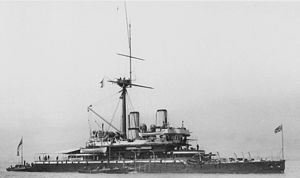 HMS Devastation in 1896
| |
| Class overview | |
|---|---|
| Builders |
|
| Succeeded by | HMS Dreadnought (1875)[1] |
| Cost | |
| Built | 1869–1877[1] |
| In service | 1874-1905 |
| In commission | 1873-1909 |
| Planned | 2 |
| Completed | 2 |
| Retired | 2 |
| Scrapped | 2 |
| General characteristics [4] | |
| Displacement | 9,330 long tons (9,480 t) |
| Length | |
| Beam | 62 ft 3 in (18.97 m) |
| Draught | 26 ft 8 in (8.13 m) |
| Propulsion |
|
| Speed | |
| Range |
|
| Complement | 410 |
| Armament |
|
| Armour |
|
The two British Devastation-class battleships of the 1870s, HMS Devastation and HMS Thunderer, were the first class of ocean-going capital ship that did not carry sails, and the first which mounted the entire main armament on top of the hull rather than inside it.
The ships were designed by Sir Edward Reed, whose concept was to produce short, handy ships of medium size as heavily armed as possible with a good turn of speed, that could attack and destroy an opponent without much risk of being damaged during the process.[10]
- ^ a b Jane & Wyllie 1915, pp. 312–317.
- ^ Gibbs & Gibbs 1896, p. 14.
- ^ Gibbs & Gibbs 1896, p. 20.
- ^ Gibbs & Gibbs 1896, pp. 14, 20.
- ^ King 1877, pp. 37–45.
- ^ a b Jane & Wyllie 1915, p. 317.
- ^ Jane & Wyllie 1915, p. 315.
- ^ Jane 1969, p. 209.
- ^ Jane & Wyllie 1915, p. 312.
- ^ Jane & Wyllie 1915, p. 264.